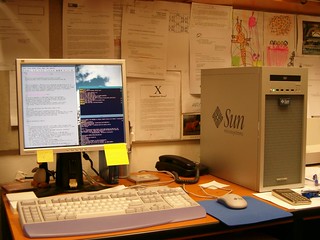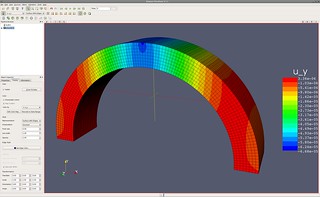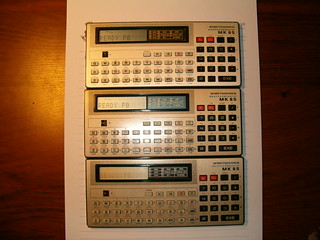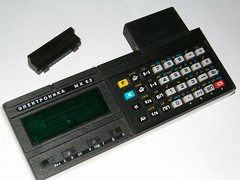Now I have both and actually I was a long-term user of Nokia’s Internet Tablets. I got the Nokia 770 in 2006 as a new (and for a horrible price, of course). In 2008 I got the N800 and later also the N810. I stopped to use them around 2011 (I think). It was when I started to actively use the Ben NanoNote and the OpenMoko phone. The later Nokias are more capable than the both mentioned devices but they are also much bigger. Now I have only the Nokia 770 but I don’t use it.
Before few days I found the Nokia 770 during cleaning and I have decided to test it against the Zaurus. It’s a Linux handheld from a similar era, it has similar power so it can be interesting to see the diferrences.
Similarities
Before I start to write about the differences it may be usefull to repeat the similarities: both machines use a Linux-based operating system (the GUI is different: the Zaurus has a Qt-based Qtopia by default but the 770 uses the Maemo which is based on the Gtk+). Both machines have only 64 MB of the RAM and no hard disc. They have just a flash storage (up to 128 MB in the Zaurus and the same size in the 770). This mean some limits for number of applications and also strict limits for some uses (one is limited to about 3 opened WWW pages in both cases – which is a pity especially on the 770 which was marketed as a “Internet Tablet”). Also use of something like OpenOffice is rather impossible.
Main use
Tne 770 was designed as a dedicated WWW/RSS/E-mail device with possibility to be extended by 3rd-party applications. There is no office software and no PIM software by default. Even the microphone was not enabled by default. Of course it has build-in WiFi (but it was a bit obsolete even in 2006) and Bluetooth (initially dedicated tu connect a phone for file transfer and for use phone’s GSM data connection). The Zaurus is a more general-use PDA device which came with an office suite and a PIM suite by default (and also with Qtopia Desktop synchronisation application for the Windows and the Linux desktop machines). There is no build-in wireless connection in the Zaurus but it has more extension slots instead.
Stylus
What? Yes, both machines have a classical, stylus-controlled touchscreen. The 770 has wider and bigger screen (800×480 resolution) than the Zaurus (640×480 for all clamshell models). Both styli are cheap plastic ones. Both are too short for my liking but they can be fine for most people. The Zaurus has is more rounded and is more comfortable to handle – the one for the 770 is too flat. The newer Nokias had different styli, by the way. There are possibilities to get a metal stylus with a plastic cap for the Zaurus (both original and third-party). They are even available today. The 770’s stylus is a problem because it is the sole input device for the machine. I used a combined pen/stylus for the device (and lost it because it of course didn’t fit in the stylus bay).
Keyboard
The 770 don’t have one. One can use a Bluetooth one (a support for that was added by free software developers). I used the SU-8W here. It’s quite good (expect the limited number of keys which caused frequent use of fn key and expect it rather ugly look). It mostly worked but in some situations it was less reliable which caused missing or repeating letters.l
The Zaurus has a build-in keyboard. Different Zauru have differen keyboard. The C3200’s one reminds a cassical calculator keyboard (or a HP 200LX-style keyboard). The C760 has a different, a more flat design whis seems to be z a less comfortable to me (anuyway it is possible to type on it relatively fast – I use it to make this text). In fact the build-in hardware keyboard is better for actual typing. It is of course less comfortable for a typical WWW browsing which needs a lot of stylus taps but the entered texts are usually short (login data, www addresses and so). Then the use of stylus only is more consistent and also de facto more comfortable.
WiFi
The Zaurus has no such possibility (except models like 6000L) so CompactFlash card have to be used. There is a problem with ergonomy: the CF flot is on the right side if the device and no WiFi card can be completely hidden in the slot (the antenna part is always outside). It makes it uncomfortable to hold. It’s not a problem when it ists on the table but it is a problem when it is hold in hands (which is a bit more usual use of a PDA, I think). Both devices have problems to connects to modern (protected) WiFi networks. The 770 is better here as most ot the Zaurus software was somewhat problematic (limited searching for networks and so).
Bluetooth
The 770 can be easily connected to a (compatible, not modern) keyboards, GPS receivers and phones. The Zaurus requires to use a Bluetooth card (inserted to a CF slot – so WiFi and Bluetooth cards not be used at once).
Sound
There are media players so the sound is important. The 770 has a speaker and a 3.5″ headphone connector. Many of Zauri don’t have speakers and I also had an issues with several types of headphones (no such problems were with the 770).
Screen
The 770 has a bigger and more nice screen but the Zaurus’s screen is mostly sufficient, too. And there are differences between Zauri (the c3200 has a very nice screen, both brightness and colors are great). The resolution is comparable (800×480 vs 640×480) but extra pixels on the 770 make viewing of some WWW pages and PDFs easier.
Battery life
The 770 was marketed to have the battery life about 3 hours with running WiFi. And it is true. It’s even a bit better. The Zaurus is comparable. Both devices have 6-8 hours without wifi and with lowwr screen backlight and it can survive at least week when suspended. This is something that both NanoNote and OpeMoko phones can’t archieve, unfortunately.
WWW Browser and RSS/Atom reader
It’s Opera. The version is 6.x which is prehistoric by today’s standards but it was a current browser when it was new. In both cases it has a small screen mode which makes even some modern WWW pages readable on these devices. There is a build-in RSS,Atom feed reader in the 770 and it is nice. The Zaurus can use the Zocalo which is great and it was actively developed until 2013. My only compliant is that launch of WWW browser requires a stylus click on an icon (I didn’t find any keyboard shortcut for that).
I don’t use mail clients on these machines due to lack of security today.
Office software
There is none by default on the 770. An AbiWord and a Gnumeric can be installed. The second is stable and near full-featured spreasheet. The AbiWord was a few caveats and is was slow on the device ut it was OK solution for most of cases. The Zaurus had a simplified word procesor and spreadsheed (na graphs, for example) as default and a more powerfull (closed-source) word processor was able to obtain.Tn both cases no DOCX files can be opened (people used to send me this stuff). And there is no TeX/LaTeX solution for 770 but there is a basic teTeX distribution (which includes basic LaTeX support) for the Zaurus.

Other software
The Zaurus is Qt-based (no X11) thus it has lower initial memory requrementa. It’s desktop resembles a normal PC desktop (something like the Start …errr Qt button and a taskbar on the bottomand program icons on the desktop). The Nokia’s own Maemo desktop is different and it looks to be a bit more elegant. It also support some types of desktop widgets. The Maemo is X11 based and it uses Gtk+ library. So both memory consumption and the versatility is much bigger. One even can compile (also onboard with some effort!) normal Gtk+ applications and use them with some limitations (they are not visible in the Maemo taskbar and they can not use integrated menus nor visual theme) . I once compiled and then used my uFEM software which uses basic OpenGL stuff (with use of the Fabrice Bellard’s TinyGL library).
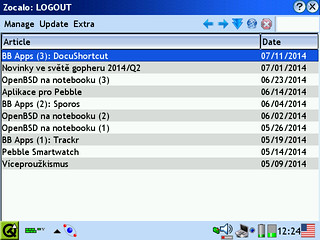
Modern devices
Well, for on-line tasks I have to use something different. But on the move I work mostly off-line (I even have disabled data connection in my phone). Thus the order of my preferred portables of the moment is:
- Ben NanoNote (if I will be able to repair one…),
- Zaurus SL-C760,
- any other clamshell Zaurus,
- Nokia 770,
- Palm III-compatible device,
- DOS-based palmtop (HP 200LX),
- modern (Android-based) phone/tablet.



